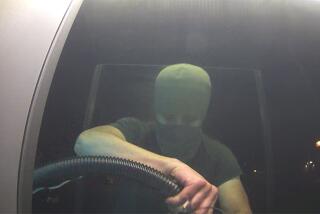Ng Says Death Threats on Videos Were ‘Bluffs’
- Share via
Confronted with grisly videos considered the strongest evidence against him, accused serial killer Charles Ng on Monday said death threats made to two victims on the recordings were “bluffs” and that his brutal behavior was intended only to “erotically turn on” his alleged accomplice.
Ng, accused of murdering 12 people, took part in the videos recorded at the Calaveras County home of his alleged accomplice, Leonard Lake, where the bodies were found. In the videos Ng taunts, disrobes and threatens two women who were allegedly used as sex slaves before being killed along with the rest of the victims in the mid-1980s.
Prosecutors in Santa Ana point to the tapes as proof of Ng’s involvement in the killing. But Ng, who says Lake was responsible for the murders, insisted he was playing a role as part of Lake’s sadomasochistic fantasies.
“Part of the game meant that whatever Leonard Lake said, I kind of concurred,” Ng explained during the second day of cross-examination by Deputy Atty. Gen. Sharlene Honnaka. “It was to project solidarity and seriousness of what we were doing.”
Ng said he based some of his actions in the videos on sequences in films that he knew Lake enjoyed, in particular, a scene from one of the “Death Wish” films, in which a victim’s shirt is ripped off.
“I thought this act might turn him on,” he said, explaining why he tore off the shirt of Brenda O’Connor. “I was trying to act macho.”
In the two videos, Ng can be seen handcuffing the victims, putting their legs in manacles and supporting Lake’s threats that they could end up dead like other victims. At one point, he tells O’Connor her pleas are futile because he and Lake are “cold-hearted.”
The other victim, Kathleen Allen, can be seen massaging Ng in another video. Ng denied raping either woman, though he admitted he wanted to have sex with Allen.
“I felt sorry for her so I couldn’t do it,” he said.
He and Lake, he said, bound the bodies with handcuffs and rope and then put them in sleeping bags before burying them in a pre-dug grave on Lake’s property.
Despite the murders Lake committed, Ng said he didn’t think his friend was capable of killing women.
Ng said he regretted taking part in the videos and cut short his trip to the remote cabin to return to his home in San Francisco. “I didn’t want to be up there,” he said. “I didn’t want to get further involved.”
Victims’ family members doubted Ng’s story. “Is he going to admit he killed them? Give me a break,” said Sharon Sellitto, the sister of one of the victims. “The only thing he regrets is getting caught.”
Lake committed suicide in 1985 after he was arrested for shoplifting a $75 vise from a South San Francisco lumberyard.
Honnaka stepped up her efforts to discredit Ng, introducing evidence that included cartoon drawings by Ng that depict women and children being tortured. Ng admitted he drew most of the cartoons while awaiting extradition in a Canadian prison.
“I can explain,” Ng said repeatedly when faced with the evidence.
He said they did not reflect actual events but were satirical drawings that represented his frustration with his situation. “This was my way of ridiculing charges that I had no way to defend at that time.” Ng said.
One drawing showed a mother holding a baby on a plate with the caption: “Daddy dies. Mommy cries. Baby dies.”
When asked what the baby was doing, Ng said it was a “microwave baby.”
He said he drew the cartoon after hearing what he labeled “wild prison rumors” that he and Lake had microwaved babies.
Another drawing, headed with the caption “Lake’s Baby Die School,” showed Ng wildly swinging a baby in a pillowcase. Lake is shown prepared to dump two babies into a barrel of water.
More to Read
Sign up for Essential California
The most important California stories and recommendations in your inbox every morning.
You may occasionally receive promotional content from the Los Angeles Times.










